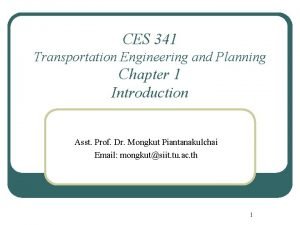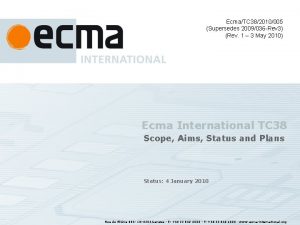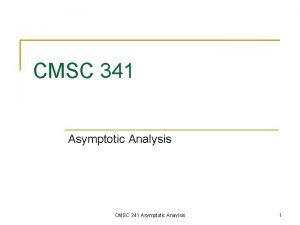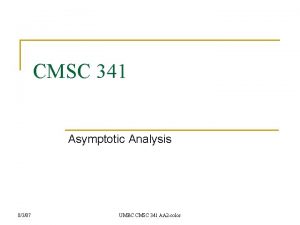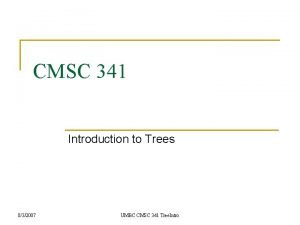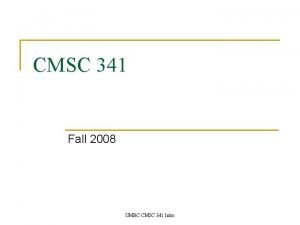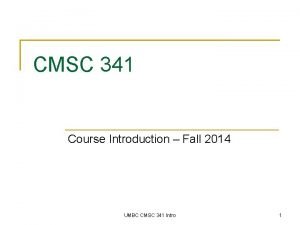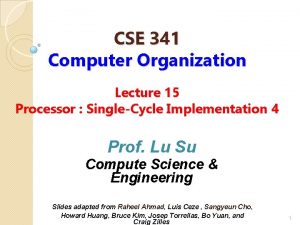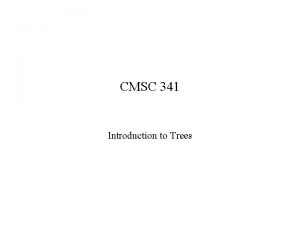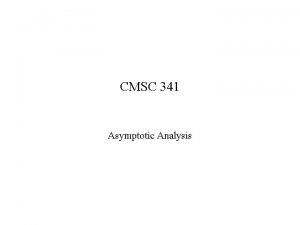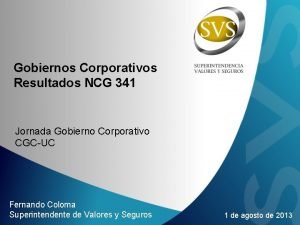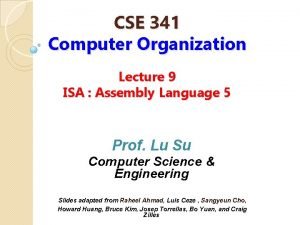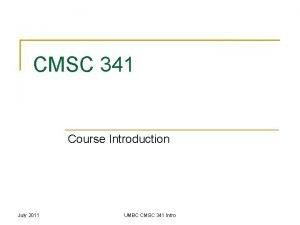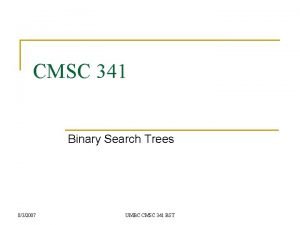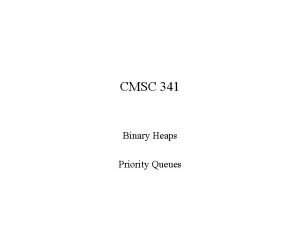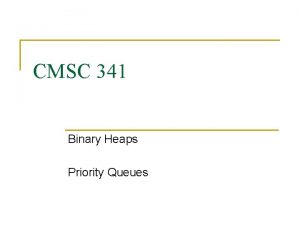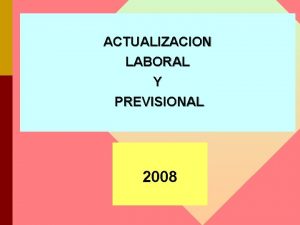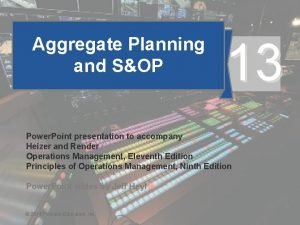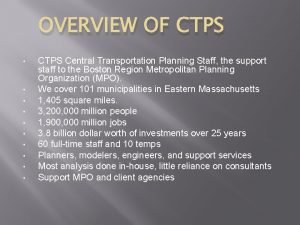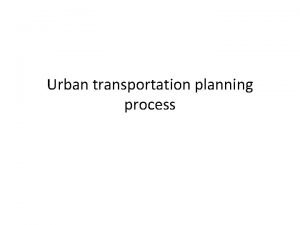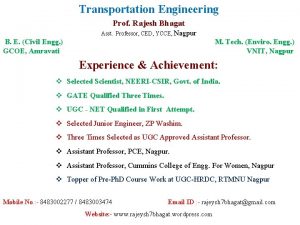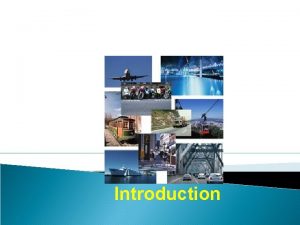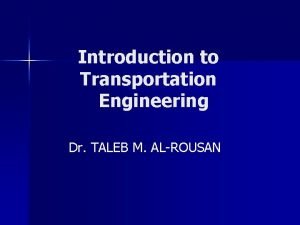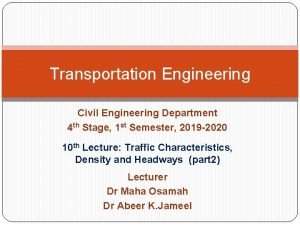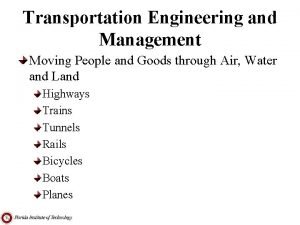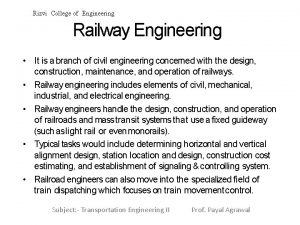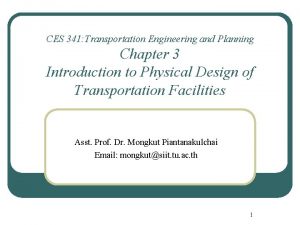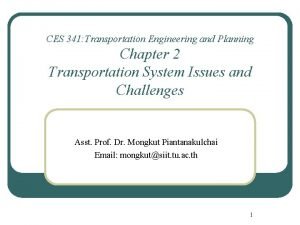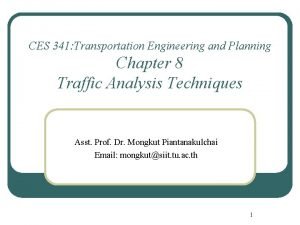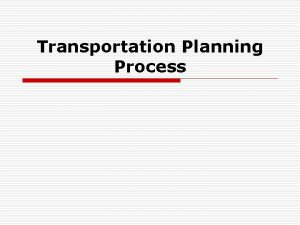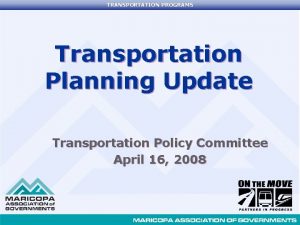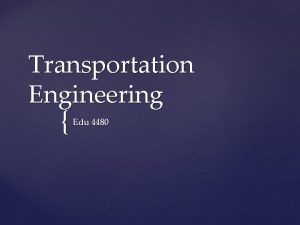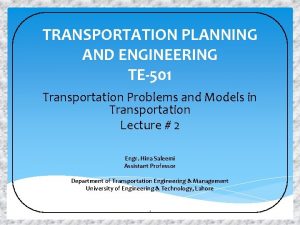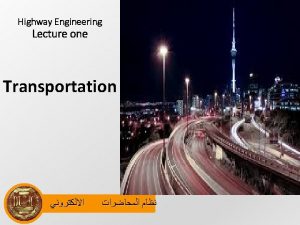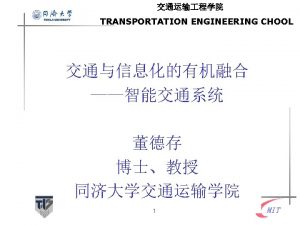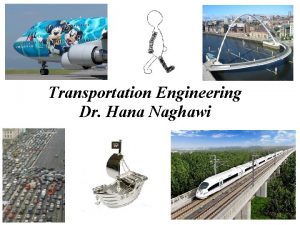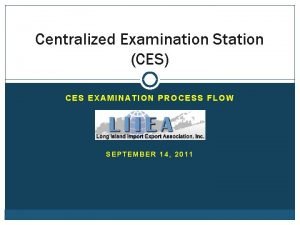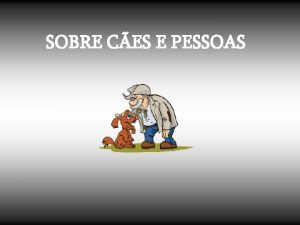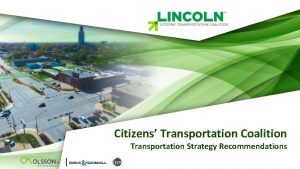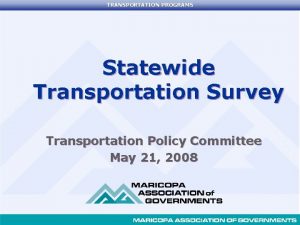CES 341 Transportation Engineering and Planning Chapter 1

































- Slides: 33

CES 341 Transportation Engineering and Planning Chapter 1 Introduction Asst. Prof. Dr. Mongkut Piantanakulchai Email: mongkut@siit. tu. ac. th 1

Learning Objectives Scope and inter-relationship of transportation engineering other fields of study The transportation system as a functional system of the society Modes of transportation Institutional structure Role of civil engineering in transportation CES 341 Transportation Engineering and Planning Chapter 1: Introduction 2

1. 1 Transportation Engineering: Scope l Application of scientific principles l Focus to “Transportation Systems” Multi-disciplinary Physics and mathematics background l l • Planning • Design • Operation • Management CES 341 Transportation Engineering and Planning Chapter 1: Introduction 3

Learning Objectives Scope and inter-relationship of transportation engineering other fields of study The transportation system as a functional system of the society Modes of transportation Institutional structure Role of civil engineering in transportation CES 341 Transportation Engineering and Planning Chapter 1: Introduction 4

1. 2 The Transportation System l Transportation as a functional system that provides a service – the movement of goods and people from place to place CES 341 Transportation Engineering and Planning Chapter 1: Introduction 5

1. 2. 1 Scope and Functional Organization l The transport functional system consists of the following components • Physical facilities • Fleets • Operating bases and facilities • Organizations • Facility-oriented organizations • Operating-oriented organizations – carriers • Operating strategies CES 341 Transportation Engineering and Planning Chapter 1: Introduction 6

1 -1 CES 341 Transportation Engineering and Planning Chapter 1: Introduction 7

1. 2. 2 Objectives and Constraints l Objectives/Motivations of transport investment • Military, Political • Road network by Romans and Napoleon • German autobahns built by Hitler in 1930 s • Intercontinental railroads in US • Economic • Provide “Time and Place Utility” – The value of goods depends on where and when they are there CES 341 Transportation Engineering and Planning Chapter 1: Introduction 8

1. 2. 2 Objectives and Constraints Two conclusions about Transport and Economy 1. High economic activities require adequate transport infrastructure 2. Value of transport depends on the value of goods transported or activities performed by passengers at destinations – “transport as a secondary good/service”; “demand for transport is derived demand” CES 341 Transportation Engineering and Planning Chapter 1: Introduction 9

1. 2. 2 Objectives and Constraints Transport constraints by public policy l Environmental impact • • Evaluation of impact Specific rules what can or cannot be done CES 341 Transportation Engineering and Planning Chapter 1: Introduction 10

Learning Objectives Scope and inter-relationship of transportation engineering other fields of study The transportation system as a functional system of the society Modes of transportation Institutional structure Role of civil engineering in transportation CES 341 Transportation Engineering and Planning Chapter 1: Introduction 11

1. 3 Modes of Transportation l l Modes = Kinds of transportation (not so clear definition) Modes are distinguished by • Physical characteristics – highway, rail, air, and • • water transportation Organizational characteristics – mass transit (highway+rail) Other schemes – urban/rural/intercity, freight/passenger, etc. CES 341 Transportation Engineering and Planning Chapter 1: Introduction 12

Table 1. 1 Mode Classification Scheme Freight Passenger Urban Truck (highway) Private auto (highway) Transit (highway/rail) Intercity Truck (highway) Rail Ocean shipping Inland water Pipeline Air Private auto (highway) Bus (highway) Rail Air Special purpose Conveyor belt Cable systems CES 341 Transportation Engineering and Planning Chapter 1: Introduction 13

Descriptions of effectiveness of transport modes l l l Accessibility – cost of getting to and from the mode Mobility – speed or travel time • • Line-haul speed/travel time Door-to-door speed/travel time Productivity – measure of the total amount of transportation per unit of time • • Total amount of transportation – product of volume of goods or passenger carried and distance Examples: ton-miles/year, passenger-km/day CES 341 Transportation Engineering and Planning Chapter 1: Introduction 14

Descriptions of effectiveness of transport modes l Transportation costs • Capital costs • Right-of-way costs • Construction costs • Vehicle costs • Operating costs – day-to-day expenditures • Fuel/energy costs • Labor costs • Expendable parts (vehicles) • Maintenance of facilities/ equipment CES 341 Transportation Engineering and Planning Chapter 1: Introduction 15

Transport Markets l l Passenger • • Urban Intercity • Short (<160 km) • Medium (160 -800 km) • Long (>800 km) Freight • • Bulk freight (low value per unit weight or volume) General cargo (manufactured goods) CES 341 Transportation Engineering and Planning Chapter 1: Introduction 16

Highways l l l Dominant transport mode in most countries High accessibility Low door-to-door travel time Moderate line-haul speeds Moderate capital cost High operating cost CES 341 Transportation Engineering and Planning l High environmental impact (air pollution) Chapter 1: Introduction 17

Urban Transit l l l Buses Street cars Light Rail Transit (LRT) Rail Rapid Transit Paratransit • • Jitneys (shared taxi) Dial-a-ride l Characteristics • • • Choice riders Captive riders Speed • • • CES 341 Transportation Engineering and Planning Mostly serve passengers Urban Transit Markets Same as automobiles if road space is shared High if dedicated right-of-way (LRT, rail) with stations are far apart Accessibility– depends on spacing of stations Chapter 1: Introduction 18

Urban Transit l Characteristics • Capacity: high • Capital costs: high • Operating costs: moderate; operating cost/trip is • normally higher than fare (need subsidization) Environmental impact: Lower than auto CES 341 Transportation Engineering and Planning Chapter 1: Introduction 19

Air Transport l l l Air transport system • • • Commercial airlines Airfreight carriers General aviation (private aircraft) Market: for long distance travel (inter-city, international) Speed –high line-haul speed Accessibility –limited but not significant Capacity –moderate Productivity –high due to long distance and high speed CES 341 Transportation Engineering and Planning Chapter 1: Introduction 20

Air Transport l l Capital cost – high Operating cost –high But high productivity made moderate cost/trip (fare( Environmental impact – noise impact CES 341 Transportation Engineering and Planning Chapter 1: Introduction 21

Rail l Intercity rail –Amtrak system in US Market – intercity passengers & freight (mostly bulk cargo), with moderate trip length Speed and Accessibility –moderate • Long door-to-door travel time if mode transfers are • needed (loading/unloading) New system to save time: Unit trains, piggy back (truck trailer on flat cars) CES 341 Transportation Engineering and Planning Chapter 1: Introduction 22

Rail l Capital cost –high Operating cost – operating cost/ton-mile is low (fuel efficient) but normally high other administrative costs Environmental impact –low CES 341 Transportation Engineering and Planning Chapter 1: Introduction 23

Water l Water transport systems l Market: mainly for intercity and international freight Speed and accessibility –low Capacity –very high l l • Ocean and coastal • Inland waterways CES 341 Transportation Engineering and Planning Chapter 1: Introduction 24

Water l l l Capital cost –high Operating cost – operating cost/ ton-mile is very low Environmental impact –relatively low, oil spills from tankers CES 341 Transportation Engineering and Planning Chapter 1: Introduction 25

Pipelines l l l Market – crude oil, petroleum products, natural gas Speed –low Capacity –high Capital cost –pipeline, pumping stations Operating cost – very low (pumping costs) Environmental impact –low during operation but care should be taken to construction impact CES 341 Transportation Engineering and Planning Chapter 1: Introduction 26

Learning Objectives Scope and inter-relationship of transportation engineering other fields of study The transportation system as a functional system of the society Modes of transportation Institutional structure Role of civil engineering in transportation CES 341 Transportation Engineering and Planning Chapter 1: Introduction 27

Other modes: Large scale pneumatic tube systems Source: http: //www. tfhrc. gov/pubrds/fall 94/p 94 au 21. htm CES 341 Transportation Engineering and Planning Chapter 1: Introduction 28

1. 4 Institutional Structure l In the United States • Federal agencies – Under USDOT • State governments • • Local governments (city, county) Metropolitan regions • • FHWA FRA FTA FAA • • State highway departments State departments of transportation • • MPOs COGs CES 341 Transportation Engineering and Planning Chapter 1: Introduction 29

Source of funding l l User charges – fares, tolls General fund revenue – regular taxes Private investment Cross-subsidization –Ex. gasoline tax revenue or tolls to subsidize public transit CES 341 Transportation Engineering and Planning Chapter 1: Introduction 30

1. 5 Civil Engineering Involvement in Transportation l l Physical civil engineering System engineering CES 341 Transportation Engineering and Planning Chapter 1: Introduction 31

Copyright © The Mc. Graw-Hill Companies, Inc. Permission required for reproduction or display. 1 -2 CES 341 Transportation Engineering and Planning Chapter 1: Introduction 32

1. 6 Careers in Transportation Engineering: What makes it attractive? l l l Interact with public and other profession Contribute to the need of society Contribute to the protection and enhancement of the environment Involve in the application of advanced technology – Ex. Intelligent Transport System (ITS) Work outdoors Own a business or work in management CES 341 Transportation Engineering and Planning Chapter 1: Introduction 33
 341 ces
341 ces Sda hymn 341
Sda hymn 341 Ecma-341
Ecma-341 Cmsc 341
Cmsc 341 Umbc cmsc 341
Umbc cmsc 341 Rounding numbers hundred thousand
Rounding numbers hundred thousand Komax gamma 333 pc/pc-b
Komax gamma 333 pc/pc-b Cmsc 341
Cmsc 341 Umbc cmsc 341
Umbc cmsc 341 Cmsc 341
Cmsc 341 Jump instruction
Jump instruction Cmsc 341
Cmsc 341 Cmsc 341
Cmsc 341 Ck wraps
Ck wraps O mon sauveur a toi seul
O mon sauveur a toi seul Mgmt 341
Mgmt 341 Ncg 341
Ncg 341 Cs341 uwaterloo
Cs341 uwaterloo Cse 341
Cse 341 Umbc cmsc 341
Umbc cmsc 341 Umbc cmsc 341
Umbc cmsc 341 Cmsc 341
Cmsc 341 Cmsc 341
Cmsc 341 Actualizacion 341
Actualizacion 341 Transportation method of aggregate planning
Transportation method of aggregate planning Central transportation planning staff
Central transportation planning staff Urban transportation act of 1964
Urban transportation act of 1964 Scope of traffic engineering
Scope of traffic engineering About the bed
About the bed Definition of transportation engineering
Definition of transportation engineering Transportation engineering definition
Transportation engineering definition Space headway
Space headway Transportation engineering
Transportation engineering Coning of rails
Coning of rails
